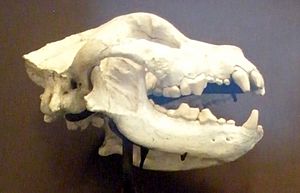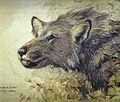Borophagus facts for kids

Borophagus was an extinct (no longer living) animal. It belonged to the Canidae family, which includes modern-day dogs, wolves, and foxes. Borophagus lived only in North America. These animals looked a bit like modern hyenas. They weighed between 20 and 40 kilograms (about 44 to 88 pounds). Scientists know of eight different types (species) of Borophagus. They lived a long time ago, from about 12 million years ago to 2 million years ago.
Contents
What was Borophagus?
Borophagus is often called a "bone-crushing dog." This name comes from its very strong jaws and teeth. These teeth were perfect for crushing bones, much like modern hyenas do. This suggests that Borophagus was a powerful predator or a scavenger. It likely ate the bones and tough parts of animals that other predators left behind.
Where did Borophagus live?
Borophagus lived across North America. Its fossils have been found in many different places. This shows that it was able to live in various environments. It shared its habitat with many other prehistoric animals. These included early horses, camels, and mastodons.
When did Borophagus live?
Borophagus lived during a time called the Neogene period. This period spans from about 23 million to 2.58 million years ago. Borophagus appeared around 12 million years ago. It continued to live until about 2 million years ago. This means it was around for a very long time, adapting to changes in its environment.
How was Borophagus different from modern dogs?
While Borophagus was part of the dog family, it was quite different from the dogs we know today. Its skull was very wide and short. This shape helped it have a very strong bite. Its teeth were also much more robust. They were designed for crushing, not just tearing meat. Modern dogs have teeth more suited for a varied diet.
Why did Borophagus become extinct?
Scientists believe Borophagus became extinct around 2 million years ago. This was a time of big changes in the environment. The climate became cooler and drier. This led to changes in the types of plants and animals available. New predators also appeared, like early cats and other canids. These new animals might have competed with Borophagus for food. Over time, Borophagus could not adapt to these changes, leading to its disappearance.
Images for kids
See also
 In Spanish: Borophagus para niños
In Spanish: Borophagus para niños


